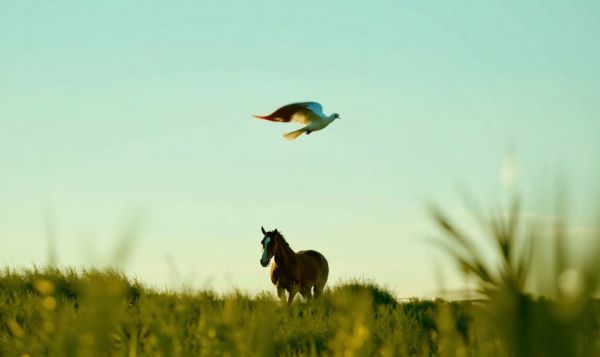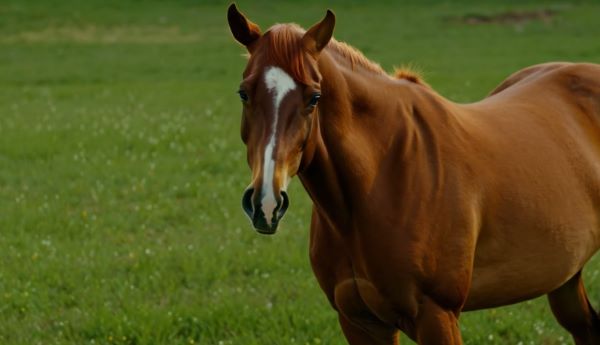“Willingness”, is the word Monty Roberts gives to the horse’s remarkable generosity.
As a teenager, Roberts observed wild horses through binoculars. He noticed they spoke to each other using body language – a language he called ‘Equus’. When a horse lowered his head and made chewing motions, he was asking to be accepted into the herd. “Can we talk?” he seemed to say.
How lucky we are, this knowledge survived. Monty’s father, who told him “hurt the horse before the horse hurts you,” certainly hadn’t inspired this thinking. And when Monty first spoke out against his father’s methods, he was beaten with a stall chain.
But who took the right approach towards the horse? The father or the son? The father’s methods certainly broke the horse, but some would argue the horse’s spirit went with it. Lawrence Scanlan, author of The man who listens to horses wrote this…
‘As part of sacking out, one hind leg was tied up with ropes and connected to a rope collar around the horse’s chest. With the horse’s foot off the ground, bucking was impossible. More sacking ensued, and finally a saddle was put on. The end result may well have been a cooperative horse, but something precious, Monty Roberts came to believe, had been lost.’
You might think it cruel. You might not. But compare this to Monty’s methods, and you’ll probably think it unnecessary. Why work hard to break a horse’s spirit, when that spirit is ‘willingness’. Work with it.
In 1997, Monty Roberts met the manic Happy Go Lucky. He rubbed the horse’s head as he talked. Using a line, he encouraged the horse to power around the perimeter of where he stood. Eventually the horse calmed, ‘maybe this man isn’t so bad’. Before long, Happy Go Lucky lowered his head and made chewing motions.
In 15 minutes, Monty Roberts achieved more than traditional horse breaking methods could achieve in 6 weeks.
“Can we talk,” Happy Go Lucky seemed to say.

And now onto Otto.
“The phrase “breaking a horse’s spirit” is often misunderstood. Traditional “breaking” methods aim to train a horse by removing resistance, but they risk diminishing a horse’s natural curiosity and willingness. In contrast, modern approaches to horse training focus on maintaining and even nurturing a horse’s spirit and enthusiasm for learning.”
“When a horse’s spirit is “broken” through harsh or overly forceful methods, the horse may become compliant, but often at the cost of trust, connection, and self-confidence. Horses are naturally curious, social animals that thrive on positive interactions and learning experiences. Harsh training methods can instill fear and discourage the horse from thinking independently, resulting in a horse that may obey but lacks the willingness and enjoyment that make a true partnership with a human rewarding.”
“Why break a horse’s ‘willing’ spirit? Instead of breaking a horse’s spirit, training should aim to guide and develop it. Using positive reinforcement, patience, and consistency, trainers can build a strong foundation of trust and respect. When a horse understands and feels comfortable with what is being asked, they’re more likely to respond willingly and with enthusiasm. This approach keeps the horse’s spirit intact, fostering a more willing and responsive partner.”

“Keeping a horse’s spirit alive also leads to better long-term behavior and emotional health. A willing horse is less likely to develop anxiety-related issues or resistance over time. Additionally, it enhances the relationship between horse and rider, creating a bond built on respect rather than fear.”
“Ultimately, the goal of training should be to develop a horse that is not just obedient, but also engaged, trusting, and happy. Preserving a horse’s spirit makes for a safer, more cooperative, and enjoyable experience for both horse and human, creating a partnership that honors the horse’s natural intelligence and sensitivity. Otto”
Next up
Am not sure if I have this chewing motion as my boy does a lot of movemen with his mouth when I walk to him. He will come over for his kisses which I plant on his mouth and talk to him. So I would like to know if there is somewhere on the net that I can see this in motion so I can recognise it. I am learning more and more from this site and for thank I thank you. I have a wonderful bond with my horse, when I got him he used to bite and the last owner and her children would smack him in the face. I refuse to do this as I train dogs and never once smack any of mine my voice is enough. I told him gently and when he did not listen I would walk away. He would come after me after a while and nudge me, again I would walk away and when he came a second time I would turn around and I will start the whole process over, over three weeks he stopped biting and now grooms which now and again can hurt but I know he is grooming so I ask him to be gentle and he normally pulls back looks and then nudges and stands there with his head on mine. I want to learn more and more as it will only help me and him. Again everyone thank you.
I have allowed my horses to groom me for years.They make the best back scratchers! I do this with all of our farms horses,even our stallion.I feel this makes for a better relationship when working with them.I also have taught our horses to come in from the field when we clap our hands,this is much easier on your vocal cords!
Ehh. When you have seen an expensive show shirt ripped off a girl by a horse giving her an over enthusiastic groom you may reconsider the safety of mutual cleanliness.
My horse doesn’t get to groom me. If she reeeeeeally wants I allow her to *groom* the knob end of my training whip. In my mind, Its painful and irritating.
simple solution. let your horse groom you if and where you enjoy it… at home 😆
I agree with Lily and in the case of our horses, if you groom them gently, they will groom you gently. Our horses seem smart enough to figure out that if they want the scratching to continue they must be gentle to us. Fred and Joan.
My horse in the beginning didn’t like to be touch or groomed but in a few days she began to love it. Now she stands still and ground ties nicely and stopped trying to kick inward with her back legs and paw the air with her front legs. I agree about the chewing. My horse now whinnies at me when I come toward the barn to feed her before going into the pasture and she does that chewing movement with her mouth with no food in it and lowers her head. We have become trusting of each other now and have a language we share. 😛
Hello every on i by i horse last January a forest pony 2 years old and the first time i try to get close to hem hi was in the stables i pot my hand on hies back and he tern very quickly with he fit in the ear to worth me and he bet me in my chest .
I new he pot my confident back to the beginning but riding all yours comets meek me persevere and i went to the stables when i cud and token to hem and watch for along time on till these morning he was in manage and i diced is to day and i open the gate pot the rope on his collar and bring out of the manage to a small patch off grass and i start to groom him today he is a different horse and my best friend .MY lesson is never giving op on yours horse and with the time the horse will reword you more forever. I JUST TO SHIRE MY EXPERIENCE WITH YOU .
Why is it important to avoid breaking a horse’s spirit during training?
Avoiding harsh training that breaks a horse’s spirit helps maintain their natural curiosity, trust, and willingness to engage. Positive, gentle training methods build a strong bond based on respect rather than fear, resulting in a happier, more responsive horse that enjoys working with its rider. This approach benefits both the horse’s emotional well-being and the overall partnership.